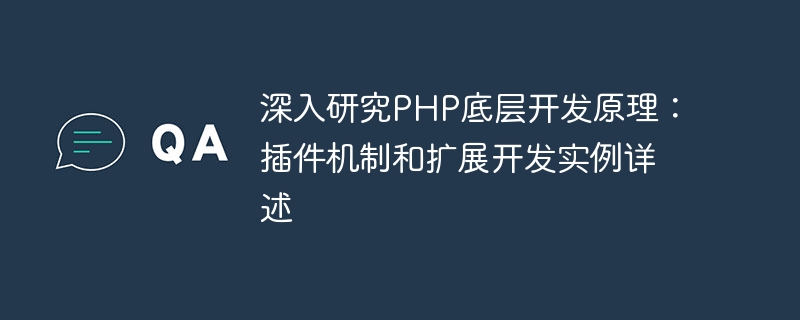

In-depth study of the underlying development principles of PHP: detailed description of plug-in mechanism and extension development examples
PHP is a popular server-side scripting language , its flexibility and ease of learning are loved by developers. Although PHP itself has provided a wealth of built-in functions and features, sometimes we need to carry out customized development according to our own needs, which requires an in-depth understanding of the underlying development principles of PHP. This article will focus on the underlying plug-in mechanism and extension development examples of PHP to help readers better understand and apply these principles.
In PHP, the plug-in mechanism is implemented through extension. An extension is a library written in C language that provides additional functionality to the PHP runtime environment. We can use extensions to change the behavior of PHP, add new functions and classes, or optimize performance.
In order to insert an extension, we need to edit the php.ini configuration file and add extension=xxx.so (extension=xxx.dll for Windows systems), where xxx represents the extension name. You can also use the dl() function to load extensions at runtime, but this method has been removed in PHP 5.3 and later versions.
Based on the plug-in mechanism, we can develop extensions with various specific functions. Below we will introduce the extension development process in detail through an example.
First, create a plugin.c file, which contains the following code:
#ifdef HAVE_CONFIG_H
#include "config.h"
#endif
#include "php.h"
#include "php_plugin.h"
ZEND_FUNCTION(hello_world) {
php_printf("Hello, world!
");
}
static zend_function_entry plugin_functions[] = {
ZEND_FE(hello_world, NULL)
{NULL, NULL, NULL}
};
zend_module_entry plugin_module_entry = {
STANDARD_MODULE_HEADER,
"plugin",
plugin_functions,
NULL,
NULL,
NULL,
NULL,
NULL,
NO_VERSION_YET,
STANDARD_MODULE_PROPERTIES
};
#ifdef COMPILE_DL_PLUGIN
ZEND_GET_MODULE(plugin)
#endif#ifdef HAVE_CONFIG_H in line 2 of the code is a conditionally compiled macro, using to import the configuration file. Lines 3 and 4 introduce PHP and extension-related header files respectively.
Line 6 is the specific implementation of the function hello_world we want to add. This function uses the php_printf function to output the string "Hello, world!".
Line 8 defines a zend_function_entry structure array, which contains the function hello_world we want to add.
Line 10 defines a zend_module_entry structure, which contains module information. It should be noted that the module name should be consistent with the parameters in the subsequent ZEND_GET_MODULE function.
Line 15 is a conditionally compiled macro used to export module information so that it can be loaded by PHP.
Next, we need to use the tools provided by PHP to compile and install this extension. Execute the following command in the command line:
$ phpize $ ./configure --enable-plugin $ make $ sudo make install
Among the above commands, the phpize command is used to generate the compilation configuration file. The configure command is used to detect the system environment and configure compilation options, where --enable-plugin is our customized option. The make command is used to compile extension source code and generate dynamic link library files. The sudo make install command is used to install extensions in the system directory.
After the installation is completed, we need to add the following content to the php.ini configuration file:
extension=plugin.so
After the configuration is completed, restart the PHP service.
Now, we can use the extension we just developed in our PHP code. Create a test.php file containing the following code:
<?php hello_world(); ?>
Execute the following command on the command line:
$ php test.php
The output will be "Hello, world!". This is when our custom extension takes effect.
This article introduces in detail the plug-in mechanism and extension development examples in the underlying development of PHP. The plug-in mechanism is implemented through extensions, which can change the behavior of PHP, add new functions and classes, or optimize performance. Write the extension in C language, then compile and install it, and finally enable the extension in php.ini. Developers can carry out customized extension development according to their own needs to meet more complex application scenarios.
The above is the detailed content of In-depth study of the underlying development principles of PHP: detailed description of plug-in mechanism and extension development examples. For more information, please follow other related articles on the PHP Chinese website!




